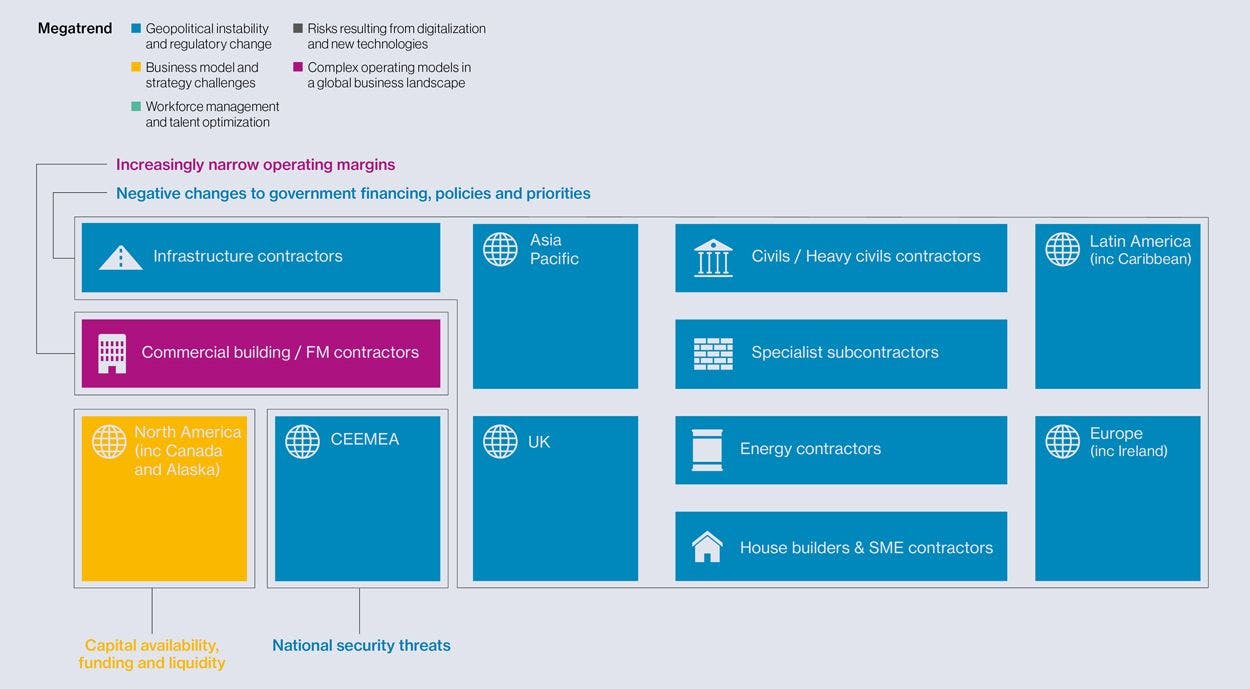
Key Risks Facing the Construction Sector
Survey provides insights into the risks and challenges facing construction globally
What are the key issues concerning construction executives? The recently published Willis Towers Watson Construction Risk Index was commissioned to gain a deeper insight into the risks and challenges facing the construction sector globally.
The 350 senior executives in this quantitative survey were asked to rank the greatest threats to their businesses — both today and 10 years from now. These threats were based around 50 specific risks from five overarching megatrends:
- geopolitical and regulatory change;
- workforce management and talent optimization;
- business model and strategy challenges;
- digitalization and new technologies; and
- complex operating models in a global business landscape.
The goal was to understand how the various stakeholders in the industry view their risk landscape, and to use these findings to build better solutions to help clients realize opportunity in an uncertain and challenging environment.
The index enables contractors, developers, owners and other stakeholders in the construction supply chain to help identify many of the challenges facing the sector. It allows them to anticipate future risk profiles and provides an overview of boardroom concerns in this complex marketplace.
Insights from the C-suite executives and subsequent survey results show that the industry overwhelmingly views geopolitical and regulatory risks as being of greatest concern. Construction companies operate in a global business environment where sudden cuts to government funding are not uncommon and unpredictable politics can transform an attractive new region for investment into a serious threat. This risk is also seen as the most difficult to manage and influence, thus making it harder to control.
The workforce management megatrend came a close second. It is clear that the industry fears structural challenges related to the workers it employs. Complex contracting decisions and a physically dispersed labor pool add to inherent difficulties in managing people risk. Indeed, the need for talent is likely to have the longest-term impact on the industry. Yet the results of the index show that construction companies’ inherent nature is to embrace complexity and seek out ways to differentiate themselves. There remains great optimism in the industry. As an example, one of the senior leaders interviewed in the Construction Risk Index said, “Technology is making this an exciting place to work and we are capturing the imagination of young people.”
It is clear that technology is not just a way to streamline operations but also a key driver in changing the perceptions of the construction industry as being a modern and forward-thinking place to work. The vast majority of construction organizations are embracing new technologies that will transform the future and deliver the efficiencies that have been sought for decades. Companies that fully embrace these new technologies will be the ones most likely to succeed in future markets and opportunities.
The face of the construction industry is changing rapidly—from such building methods as lean construction, robotics and additive manufacturing to digitalization of job processes and collaborative electronic environments, such as 3-D and 4-D modeling. Equipment will become smarter, and the ability to identify issues and resolve them quickly using technology will enable companies to become far more nimble.
At the same time, innovative building and delivery methods are the likely keys to growth, which will clearly require a new approach to risk management, since the challenges of working in virtual environments and the emergence of cyberattacks have created an entirely new class of risk requiring proactive measures to ensure operations remain productive and secure.
Construction has been traditionally viewed as an industry that does not adopt new methods quickly, but the survey shows that the future will demand greater efficiency than ever before, and construction companies will have to demonstrate their commitment to exploring new ideas and nurturing a culture that supports innovation — from anticipating emerging needs to supporting risk-taking — while always being mindful of the balances between risk and opportunity, if they are to be successful.
This new risk landscape also poses a challenge that requires a response from risk management partners to bring better solutions to the industry that embraces a holistic approach to risk management. Risk assessment can too easily become an exercise in setting up defensive measures to protect an enterprise. But construction has always been about creating competitive advantage by finding new ways to manage the industry’s risks to deliver better outcomes.
Related stories








